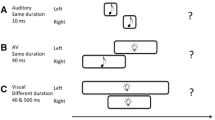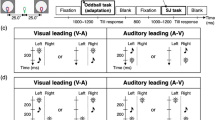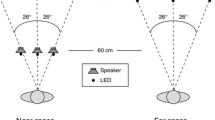Abstract
The temporal integration of stimuli in different sensory modalities plays a crucial role in multisensory processing. Previous studies using temporal-order judgments to determine the point of subjective simultaneity (PSS) with multisensory stimulation yielded conflicting results on modality-specific delays. While it is known that the relative stimulus intensities of stimuli from different sensory modalities affect their perceived temporal order, we have hypothesized that some of these discrepancies might be explained by a previously overlooked confounding factor, namely the duration of the stimulus. We therefore studied the influence of both factors on the PSS in a spatial-audiovisual temporal-order task. In addition to confirming previous results on the role of stimulus intensity, we report that varying the temporal duration of an audiovisual stimulus pair also affects the perceived temporal order of the auditory and visual stimulus components. Although individual PSS values varied from negative to positive values across participants, we found a systematic shift of PSS values in all participants toward a common attractor value with increasing stimulus duration. This resulted in a stabilization of PSS values with increasing stimulus duration, indicative of a mechanism that compensates individual imbalances between sensory modalities, which might arise from attentional biases toward one modality at short stimulus durations.






Similar content being viewed by others
Notes
Zampini et al. (2003a) found the PSS in the range of 60–80 ms versus other studies using central stimulation that found PSS in the range of 20–40 ms.
References
Alais D, Carlile S (2005) Synchronizing to real events: subjective audiovisual alignment scales with perceived auditory depth and speed of sound. Proc Natl Acad Sci USA 102:2244–2247
Arden GB, Weale RA (1954) Variations of the latent period in vision. Proc R Soc Lond Series B Biol Sci 142:258–268
Behar I, Bevan W (1961) The perceived duration of auditory and visual intervals: cross-modal comparison and interaction. Am J Psychol 74:17–26
Bertelson P, de Gelder B (2004) The psychology of multimodal perception. In: Spence C, Driver J (eds) Crossmodal space and crossmodal attention. Oxford University Press, Oxford, pp 140–177
Calvert GA, Stein BE, Spence C (eds) (2004) The handbook of multisensory processing. MIT Press, Cambridge
Carrasco M, McElree B, Denisova K et al (2003) Speed of visual processing increases with eccentricity. Nat Neurosci 6:699–700
Efron R (1970) Effect of stimulus duration on perceptual onset and offset latencies. Percept Psychophys 8:231–234
Exner S (1875) Experimentelle Untersuchung der einfachsten psychischen Processe. III. Abhandlung. Der persönlichen Gleichung zweiter Theil [Experimental examination of the most simple psychological processes. III. Treatise Second part of the personal equation]. Pflüger’s Archiv für die gesammte Physiologie des Menschen und der Thiere 11:403–432
Frey RD (1990) Selective attention, event perception and the criterion of acceptability principle: Evidence supporting and rejecting the doctrine of prior entry. Hum Mov Sci 9:481–530
Fujisaki W, Shimojo S, Kashino M et al (2004) Recalibration of audiovisual simultaneity. Nat Neurosci 7:773–778
Hanson JV, Heron J, Whitaker D (2008) Recalibration of perceived time across sensory modalities. Exp Brain Res 185:347–352
Harrar V, Harris LR (2008) The effect of exposure to asynchronous audio, visual, and tactile stimulus combinations on the perception of simultaneity. Exp Brain Res 70:807–817
Heil P, Neubauer H (2003) A unifying basis of auditory thresholds based on temporal summation. Proc Natl Acad Sci USA 100:6151–6156 Erratum in: Proc Natl Acad Sci USA 101:3323
Heil P, Neubauer H, Brown M, Irvine DR (2008) Towards a unifying basis of auditory thresholds: distributions of the first-spike latencies of auditory-nerve fibers. Hear Res 238:25–38
Hikosaka O, Miyauchi S, Shimojo S (1993) Focal visual attention produces illusory temporal order and motion sensation. Vis Res 33:1219–1240
Jaśkowski P (1991) Perceived onset simultaneity of stimuli with unequal durations. Perception 20:715–726
Jaśkowski P (1993) Selective attention and temporal-order judgment. Percept Psychophys 22:681–689
Jaśkowski P (1996) Simple reaction time and perception of temporal order: dissociations and hypotheses. Percept Mot Skills 82:707–730
Jaśkowski P, Verleger R (2000) Attentional bias toward low-intensity stimuli: an explanation for the intensity dissociation between reaction time and temporal-order judgment? Conscious Cognit 9:435–456
Jaśkowski P, Jaroszyk F, Hojan-Jezierska D (1990) Temporal-order judgments and reaction time for stimuli of different modalities. Psychol Res 52:35–38
Johnston A, Nishida S (2001) Time perception: Brain time or event time? Curr Biol 11:427–430
Keetels M, Vroomen J (2005) The role of spatial disparity and hemifields in audio-visual temporal-order judgments. Exp Brain Res 167:635–640
Kopinska A, Harris LR (2004) Simultaneity constancy. Perception 33:1049–1060
Koppen C, Spence C (2007a) Audiovisual asynchrony modulates the Colavita visual dominance effect. Brain Res 1186:224–232
Koppen C, Spence C (2007b) Spatial coincidence modulates the Colavita visual dominance effect. Neurosci Lett 417:407–411
Kuss M, Jäkel F, Wichmann FA (2005) Bayesian inference for psychometric functions. J Vis 5:478–492
Lewald J, Guski R (2004) Auditory–visual temporal integration as a function of distance: no compensation for sound-transmission time in human perception. Neurosci Lett 357:119–122
Lewald J, Ehrenstein WH, Guski R (2001) Spatio-temporal constraints for auditory–visual integration. Behav Brain Res 121:69–79
Loeb M, Behar I, Warm JS (1966) Cross-modal correlations of the perceived durations of auditory and visual stimuli. Psychonomic Sci 6:87
Meredith MA, Nemitz JW, Stein BE (1987) Determinants of multisensory integration in superior colliculus neurons. I. Temporal factors. J Neurosci 7:3215–3229
Moore CJ (2003) An introduction to the psychology of hearing, 5th edn. Emerald Group Publishing, UK
Neubauer H, Heil P (2008) A physiological model for the stimulus dependence of first-spike latency of auditory-nerve fibers. Brain Res 1220:208–223
Neumann O, Niepel M (2004) Timing of “perception” and perception of “time”. In: Kärnbach C, Schröger E, Müller H (eds) Psychophysics beyond sensation: laws and invariants of human cognition. Erlbaum, Mahwah, pp 245–269
Neumann O, Koch R, Niepel M et al (1992) Reaktionszeit und zeitliches Reihenfolgeurteil: Übereinstimmung oder Dissoziation? [Reaction time and temporal-order judgment: Correspondence or Dissociation]. Z Exp Angew Psychol 39:621–645
Nilsson T (2006) Transient effects in vision. In: Karwowski W (ed) International encyclopedia of ergonomics and human factors, 2nd edn. CRC Press, USA, pp 520–533
Parise CV, Spence C (2009) ‘When birds of a feather flock together’: synesthetic correspondences modulate audiovisual integration in non-synesthetes. PLoS ONE 4(5):e5664
Posner MI, Snyder CR, Davidson BJ (1980) Attention and the detection of signals. J Exp Psychol 109:160–174
Rains JD (1963) Signal luminance and position effects in human reaction time. Vis Res 3:239–251
Rorden C, Mattingley JB, Karnath H-O, Driver J (1997) Visual extinction and prior entry: impaired perception of temporal-order with intact motion perception after unilateral parietal damage. Neuropsychologia 35:421–433
Roufs JAJ (1974) Dynamic properties of vision-V. Perception lag and reaction time in relation to flicker and flash thresholds. Vis Res 14:853–869
Rutschmann J, Link R (1964) Perception of temporal-order of stimuli differing in sense mode and simple reaction time. Percept Mot Skills 18:345–352
Scharlau I (2004) Evidence against response bias in temporal-order tasks with attention manipulation by masked primes. Psychol Res 68:224–236
Schiefer U, Strasburger H, Becker et al (2001) Reaction time in automated kinetic perimetry: effects of stimulus luminance, eccentricity, and movement direction. Vis Res 41:2157–2164
Schimmel O, Kohlrausch A (2008) On the influence of interaural differences on temporal perception of noise bursts of different durations. J Acoust Soc Am 123:986–997
Shore DI, Spence C, Klein RM (2001) Visual prior entry. Psychol Sci 12:205–212
Slutsky DA, Recanzone GH (2001) Temporal and spatial dependency of the ventriloquism effect. Neuroreport 12:7–10
Smith WF (1933) The relative quickness of visual and auditory perception. J Exp Psychol 16:239–257
Spence C, Driver J (eds) (2004) Crossmodal space and crossmodal attention. Oxford University Press, Oxford
Spence C, Squire S (2003) Multisensory integration: maintaining the perception of synchrony. Curr Biol 13:519–521
Spence C, Shore DI, Klein RM (2001) Multisensory prior entry. J Exp Psychol Gen 130:799–832
Stein BE, Meredith MA (1993) The merging of the senses. MIT Press, Cambridge
Stelmach LB, Herdman CM (1991) Directed attention and perception of temporal-order. J Exp Psychol: HPP 17:539–550
Stone JV, Hunkin NM, Porill J et al (2001) When is now? Perception of simultaneity. Proc Biol Sci 268:31–38
Sugita Y, Suzuki Y (2003) Audiovisual perception: implicit estimation of sound-arrival time. Nature 421:911
Tajadura-Jiménez A, Kitagawa N, Väljamäe A et al (2009) Auditory–somatosensory multisensory interactions are spatially modulated by stimulated body surface and acoustic spectra. Neuropsychologia 47:195–203
Titchener EB (1908) Lectures on the elementary psychology of feeling and attention. Macmillan, New York
Van Eijk RLJ, Kohlrausch A, Juola JF et al (2008) Audiovisual synchrony and temporal-order judgments: effects of experimental method and stimulus type. Percept Psychophys 70:955–968
Vatakis A, Spence C (2007) Crossmodal binding: evaluating the “unity assumption” using audiovisual speech stimuli. Percept Psychophys 69:744–756
Vatakis A, Navarra J, Soto-Faraco S et al (2007) Temporal recalibration during asynchronous audiovisual speech perception. Exp Brain Res 181:173–181
Vatakis A, Navarra J, Soto-Faraco S et al (2008) Audiovisual temporal adaptation of speech: temporal-order versus simultaneity judgments. Exp Brain Res 185:521–529
von Helmholtz H (1867) Handbuch der Physiologischen Optik. (Algem Enz d Physik Bnd 9). Leopold Voss, Berlin
Vroomen J, Keetels M, de Gelder B et al (2004) Recalibration of temporal-order perception by exposure to audio-visual asynchrony. Cogn Brain Res 22:32–35
Zampini M, Shore DI, Spence C (2003a) Audiovisual temporal-order judgments. Exp Brain Res 152:198–210
Zampini M, Shore DI, Spence C (2003b) Multisensory temporal-order judgments: the role of hemispheric redundancy. Int J Psychophysiol 50:165–180
Zampini M, Guest S, Shore DI et al (2005a) Audio-visual simultaneity judgments. Percept Psychophys 67:531–544
Zampini M, Shore DI, Spence C (2005b) Audiovisual prior entry. Neurosci Lett 381:217–222
Acknowledgments
We would like to thank the reviewers and Charles Spence for their valuable comments. Furthermore, we would like to thank Cees van Leeuwen and Andrey R. Nikolaev for critical discussion of a previous version of the manuscript. Finally, we would like to thank Anna Fiedler and Felix Ball for assistance during data collection. This study was supported by a grant from the European Community (“DIRAC”, FP6-IST-027787).
Author information
Authors and Affiliations
Corresponding author
Rights and permissions
About this article
Cite this article
Boenke, L.T., Deliano, M. & Ohl, F.W. Stimulus duration influences perceived simultaneity in audiovisual temporal-order judgment. Exp Brain Res 198, 233–244 (2009). https://doi.org/10.1007/s00221-009-1917-z
Received:
Accepted:
Published:
Issue Date:
DOI: https://doi.org/10.1007/s00221-009-1917-z




